Some facts to get started
Guatemala has been experiencing the second most severe crisis of food security in Latin America and the Caribbean since 2020. By 2022 21.1% of the country's population was severely food insecure. This percentage increased to 26 per cent in 2023, while 58% of the population was marginally food insecure, i.e. at risk of food insecurity. The increase in chronic undernutrition in children under five years of age is of particular concern. In the school going population, the highest percentages are among indigenous children. In fact, Guatemala currently ranks sixth in the world in terms of the worst rates of child malnutrition. In some rural regions, where the majority of the population is of Mayan origin, child malnutrition rates reach 80%.
Guatemala faced several anomalous climatic phenomena in 2023, such as the extremely late rainy season, strong winds, torrential rains and low temperatures. This is of great concern among the indigenous and peasant population, as it has a huge impact on their crops. For example, most of the more than 200 communities in the municipality of Ixcán (Quiché) suffered heavy losses caused by the prolonged drought that damaged the milpa (ancestral sytem of growing corn, beans and squash together). On the other hand, in the north of Huehuetenango, heavy rains accompanied by wind caused the total destruction of crops, mainly milpa which is the main source of subsistence. Due to the delay in the rainfall, several farmers lost up to half of their crops and, when the rains finally did come, they were so strong that they destroyed everything, as well as causing land and mudslides. An unusual cold snap in mid-December caused temperatures in the west and the highlands to drop to zero degrees Celsius. The frosts froze crops and pasture for animals. There were regions where temperatures reached three degrees below zero and where sheep were found dead in the morning and cows' milk production dropped. Farmers are very worried because their livelihoods depend on these activity.
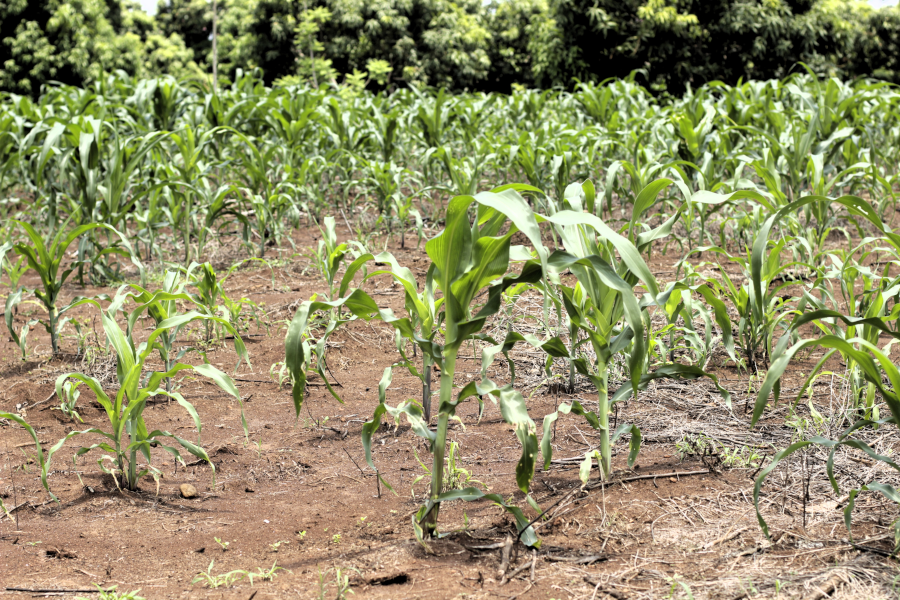
Climate and food situation in regions where PBI accompanies
Part of PBI's work includes visits to the communities we accompany. One of the struggles of these communities is the defense of their right to food. Unfortunately, we have been able to verify in-situ the increasingly precarious situation in which many peasant and indigenous families find themselves.
One of the regions affected is the South Coast. Abelino Mejía, from the Council of Communities of Retalhuleu (CCR)1 has highlighted how this year they had a very dry winter with heavy losses of milpa and vegetables. In July, almost 65% of the milpa had already dried.2 "This will impoverish peasant families even more, because it will produce more malnutrition. The lack of corn, beans, cassava, squash and peas, causes great food shortages and malnutrition, which especially affects children. It is really painful, in each community there are 20 or 30 children who are malnurished. Although the State institutions do not want to accept it, this is the sad reality that the peasants are facing and it is being repeated every year, because the families are losing their crops due to the lack of water.".

Abelino points out that the summer (dry season) is becoming longer and longer and drought is increasing in the region. The massive production of sugar cane has a lot to do with this as "rivers, streams and springs are drying up, because the sugar cane plantations monopolize the water and cause us great harm, because families want to continue planting in the summer but they have no way to irrigate."
Another region of concern is Las Verapaces. We spoke with William Pop,3 a 24-year-old Maya Pocomám and member of the Verapaz Union of Peasant Organizations (UVOC). He coordinates the work on rural development and family agriculture within the organization and explains that "normally the first rains come in May, but this year they did not arrive until July. This affected many communities that traditionally plant corn, because the heat meant that the seeds never sprouted, so the families had to plant again two weeks later. And then, when the rain came, it was very intense and for a very short period of time. That's why the harvest was so poor. Normally we harvest in September, but this year we had to wait until October and the production was very low. This is because of the weather. Families now see their food threatened and it is a serious problem, because they will have to buy in the market and the price is very high; corn is at Q200 per quintal when it normally costs between Q75 and Q100. Those who produce in large quantities have taken advantage of the scarcity by selling the product at a higher price.
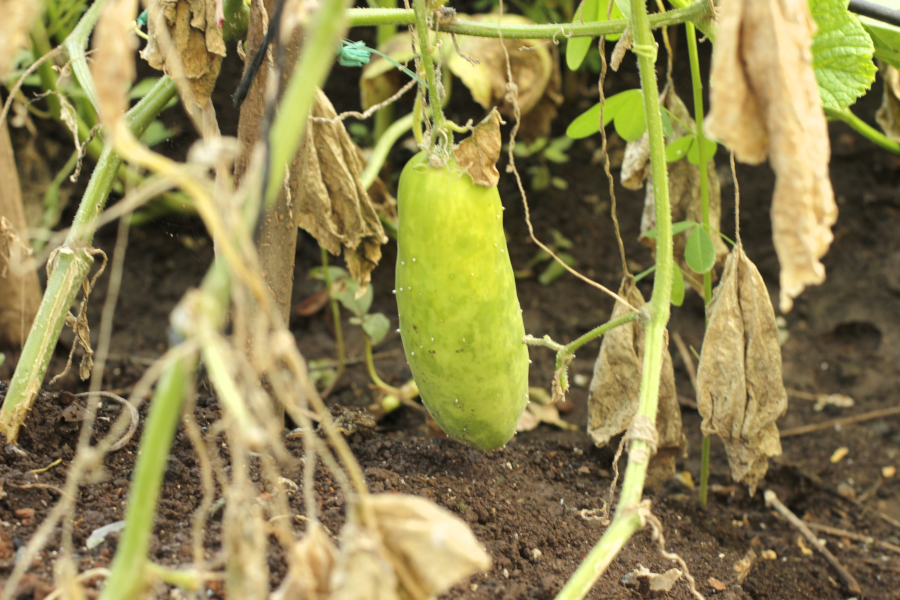
Regarding the food situation in Olopa (Chiquimula) - another of the regions where PBI provides accompaniment - it must be said that this year has improved. We spoke with Ubaldino García,4 coordinator of the Maya Ch'orti' Indigenous Council of Olopa, who shared with us that this year the rain has been very favorable for the communities. In addition, thanks to the struggle of the resistance against the mine operating in the region, they were able to secure the suspension of the mining activities and this has made more water available for the families. Although he points out that they have also experienced strange variations during the rainy season, there were no severe droughts in 2023, so they managed to harvest the crops that were planted. "It was a very good crop year for the lower part of Olopa." However, this year's favorable weather has not ensured enough food for the majority of the population, as the land available for planting is scarce. According to Ubaldino, the historical dispossession of land that they have experienced in this region is the root cause of the lack of food security. "Families have very little land to cultivate. And the lowlands5 are only enough to grow grains such as corn, beans and coffee, and often there is not enough to plant and harvest for the year. Meanwhile, in the highlands they only grow coffee,6 so they depend on selling coffee at a good price in order to buy food products. Therefore, families tend to get into debt and ask their employers for money, which they aim to pay back with the sale of the little coffee crop they have." However, this year the coffee market is complicated "because the price is very low, at half of last year's price. This has serious consequences for the nutrition of families and children because coffee is the crop they rely on and it is only harvested once a year, so all year long it has to be cared for, cleaned, fertilized.... And if in the end they don’t get a good price, it’s difficult to pay off the debt." So, "despite the fact that Olopa, being the highest municipality in the region, has better land and a better climate, it has a cultivation model that puts the food situation in general and particularly that of children at risk."
This context of instability and precarity encourages migration to the north, where the work is better paid, in order to sustain life. "Now in Olopa there are many families migrating, many young people and many members of the resistance. To finance the migration most of the land is used as collateral for payments to the coyotes. And migration is not always successful, so many families have lost their land. And that makes the food situation more complicated.
Causes of the food crisis and proposals to deal with it
We spoke with David Paredes, an environmentalist, activist for the right to food and coordinator of the National Network for the Defense of Food Sovereignty in Guatemala (REDSAG), in order to better understand the situation, its causes and some of the proposals to address it. There is still no official data from the Ministry of Agriculture, Livestock and Food (MAGA) for 2023. The information they do have comes from direct observation in the field, where there have been significant losses to corn crops. This "is especially due to irregular rainfall, one of the impacts of the climate crisis we are experiencing. Drought makes plant growth impossible, or else excess rain leads to increased pests, both of which cause crop losses. One of the important consequences is the rise in the prices of corn and beans and some vegetables in the market, which affects the economy of families."
According to Paredes, the causes of the current food crisis have deep and systemic roots. In the 1960s, the implementation of the so-called "green revolution" began, which determined "the transformation of the agricultural production model by introducing the massive use of agrochemicals. At the beginning it meant an increase in production, but with the passage of time it caused an increased dependency on these inputs as, under this model, the soil needs more and more chemicals to maintain the same levels of production, while at the same time its quality decreases. Dependence on chemical inputs makes production more expensive and many farming families do not have sufficient resources to access them. This, coupled with the climate crisis mentioned above, means that many farmers are forced to migrate to look for other opportunities to generate income to buy food, instead of producing it.
REDSAG has proposed the defense of food sovereignty as a remedy for these problems.7 Food sovereignty "is the right of peoples to produce their own food in their own way. It is tied to the long tradition of food production of indigenous peoples. It defends water, land, territory, seeds and ancestral knowledge. Agroecology is the food production system that makes it possible to move towards food sovereignty within a framework of sustainability, biodiversity conservation and the promotion of local peasant production contrary to the agro-industrial model of food exports and imports." In fact, several peasant and indigenous organizations have been working for years to recover ancestral practices and agroecology as a solution to food insecurity."
According to Abelino from the CCR, the practice of establishing and maintaining "family gardens helps us to improve the children's nutrition, because we plant blackberry, chipilín, squash, casava, sweet potato, malanga, tomato, chili, carrot, beet, onion, various herbs, salad cucumber, sweet cucumber, Creole melon,.... All this helps families to feed their children. This is how we have seen how children are overcoming malnutrition." Given the lack of rainwater on the South Coast, the families reuse the water used to wash the dishes, among other things, to irrigate the vegetable garden. "The gardens are of great importance to us, because families with little water no longer lack food. Next year, the CCR wants to implement water harvesters8 and provide the material to build them in each house.”
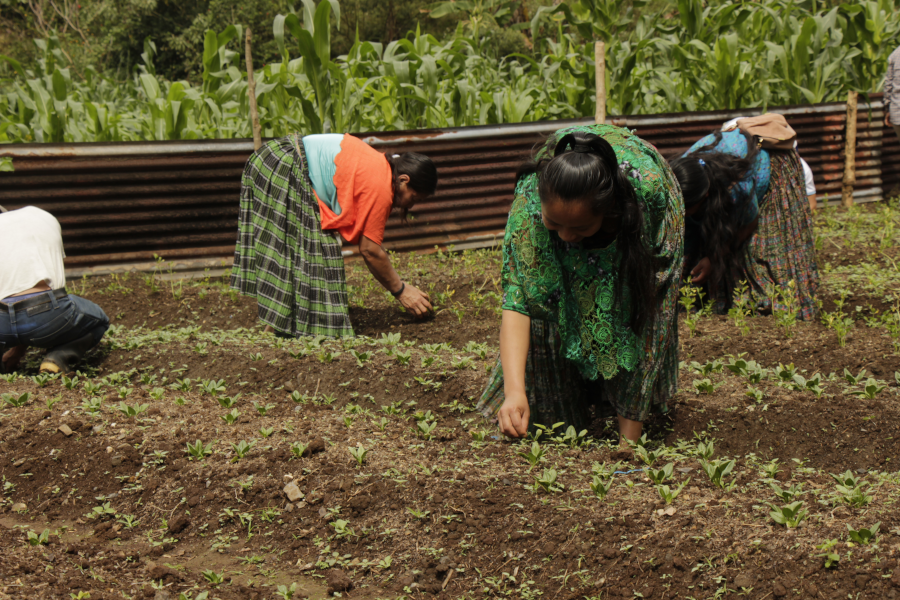
William from UVOC says that they grow vegetables, sweet potatoes, carrots, tomatoes, chives, cilantro, parsley, celery and other herbs in the family gardens. Some families manage to sell part of the products from the home gardens in community markets organized among neighbors or in the municipal market. "I estimate that we reduce food shortages by 30% through the family gardens. The planting of these vegetables and plants helps the economy of the families, because this way they don’t have to buy food." In addition, "we have implemented the use of organic fertilizer because we have to take care of the soil and nature. We also try to implemented the use of tinacas9 in communities where water is scarce and where there is no piped water. On the edges of the roofs of the houses we have installed channels that capture rainwater and take it, through pipes, to the tinacas. In this way, families have water at home to use in the kitchen, to water their plants and to water their animals.
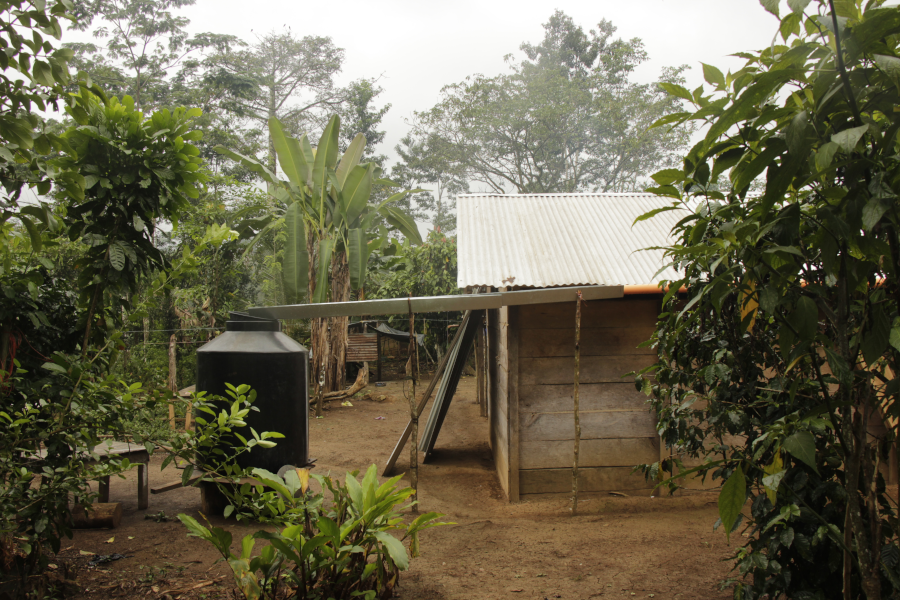
David from REDSAG comments that "Guatemala’s agrarian policy, and the measures to combat hunger, employ the complete opposite approach from the ones proposed by grassroots organizations. The State does not recognize the importance of peasant labor and small-scale production which, according to the FAO [Food and Agriculture Organization of the United Nations], provides 70% of the food consumed in the world. Guatemala voted against the declaration of peasant rights,10 which is totally illogical if we think that the largest productive sector in Guatemala are small producers, while monocultures do not feed the population. MAGA has shifted funds from the budget allocated to the Family Agriculture Program for the Strengthening of the Peasant Economy to a welfarist food delivery program, which means that instead of financially supporting the production of quality food, the state uses public funds to give away low quality food, such as palm oil and processed industrial foods that are not necessarily nutritious, but ease hunger. That is what the Guatemalan government's food security policy does: it takes away people's hunger regardless of the origin of the food. While food sovereignty recognizes ancestral knowledge, a millenary history of agriculture by the peoples that is the basis of the food that keeps us alive." The same thing happens in relation to the production system. Instead of implementing the National Strategy for the Development of Organic and Agroecological Production, which was produced in collaboration with several organizations, the MAGA prefers to work with assistance programs that deliver fertilizers and hybrid seeds that use a high percentage of chemicals, which affect the soil and water and, consequently, the health of families, and which in some cases are even prohibited in other countries. These programs have not produced the desired results. There are the malnutrition rates to prove it."
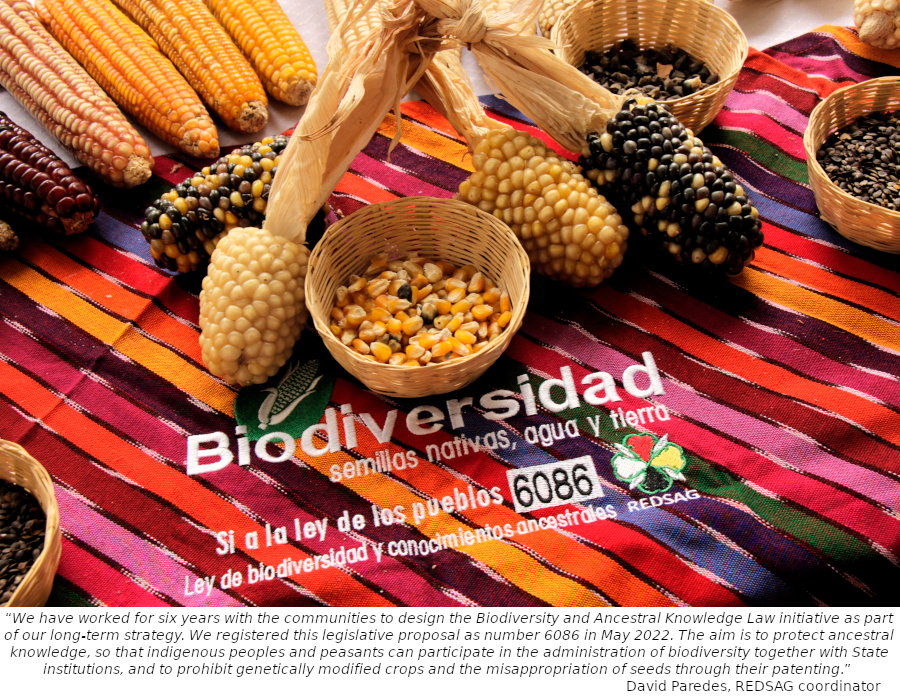
1Interviewed on January 5, 2024.
2Facebook entrace by Community Council on Food Sovereignty on the South Coast, 28.07.2023.
3Interviewed on December 28, 2023.
4Interviewed on December 30, 2023.
5Refers to land that is less than 1,000 meters above sea level, such as the communities of La Prensa, El Carrizal, Cerrón and Paternito.
6Refers to land that is more than 1,000 meters above sea level (especially suitable for coffee planting), such as the communities of La Cumbre, La Laguna, Los Planes, Tituque, Rublarcito and El Chute.
7Food sovereignty is a concept developed by La Via Campesina and brought to public debate at the 1996 World Food Summit. For more information see: www.viacampesina.org
8“They are the instruments, works or infrastructures with which rainwater harvesting can be carried out in the most efficient and optimal way for later use. Generally structured from a catchment to later lead the water to a storage source."( Extracted from: file:///home/vant/Descargas/Cosecha%20de%20Agua.pdf).
9A tinaca is a plastic container that may hold 1,100 liters of water that lasts approximately two weeks.
10The United Nations Declaration on the Rights of Peasants and Other People Working in Rural Areas was adopted on December 17, 2018 during the 73rd session of the United Nations General Assembly. It was adopted with 121 votes in favor, 8 against (Australia, Guatemala, Hungary, Israel, New Zealand, Sweden, United Kingdom and United States) and 54 abstentions.

